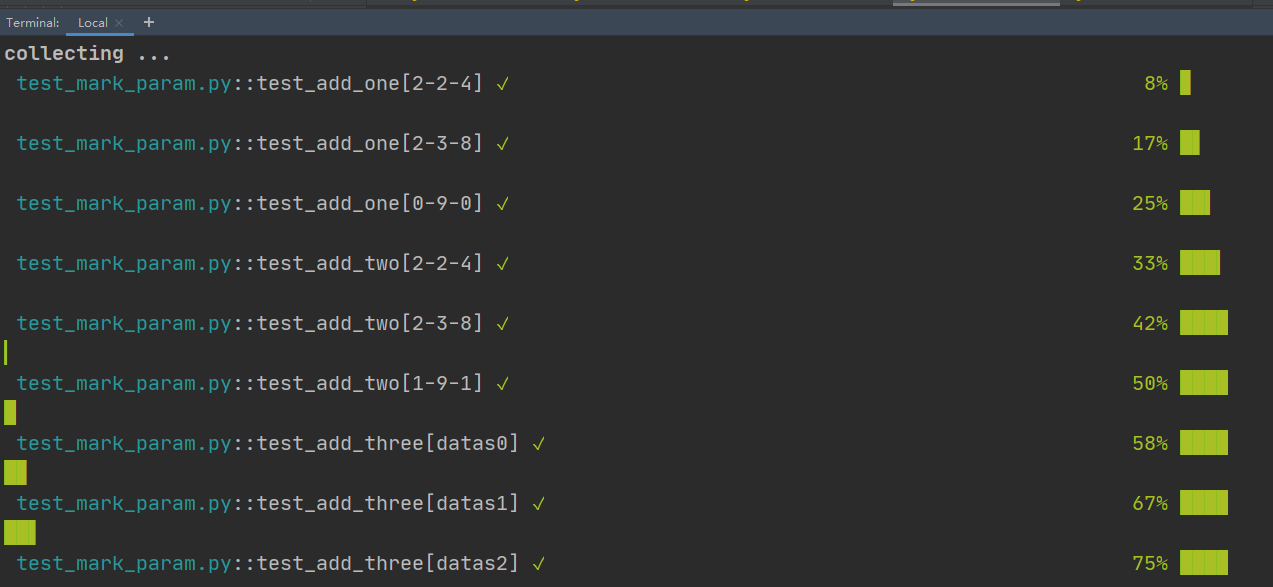1、参数化的本质:相同的步骤,但测试数据不同,比如登录的场景
import math
import pytest
# 方式一:分离出List
def list_Test():
list = [
[2, 2, 4],
[2, 3, 8],
[1, 9, 1],
[0, 9, 0],
]
return list
@pytest.mark.parametrize('a,b,expect',list_Test())
def test_add_one(a,b,expect):
# 断言 -- 某数的平方=expect对象
assert math.pow(a,b) == expect
# 方式二:分离出tuple
def tuple_Test():
tuple = [
(2, 2, 4),
(2, 3, 8),
(1, 9, 1),
(0, 9, 0),
]
return tuple
@pytest.mark.parametrize('a1,b1,expect1',tuple_Test())
def test_add_two(a1,b1,expect1):
# 断言 -- 某数的平方=expect对象
assert math.pow(a1,b1) == expect1
# 方式三:分离出dict
def dict_Test():
dict = [
{'a': 2, 'b': 2, 'expect': 4},
{'a': 2, 'b': 3, 'expect': 8},
{'a': 2, 'b': 4, 'expect': 16},
{'a': 1, 'b': 9, 'expect': 1},
]
return dict
@pytest.mark.parametrize('datas',dict_Test())
def test_add_three(datas):
# 断言 -- 某数的平方=expect对象
assert math.pow(datas['a'],datas['b']) == datas['expect']
# 方式四: 使用pytest.param方法进行分离
def param_Test():
param = [
pytest.param(1, 1, 1,id='one'),
pytest.param(2, 2, 4,id='two'),
pytest.param(3, 3, 27,id='three')
]
return param
# ids参数默认为None,用于定义测试用例的名称
@pytest.mark.parametrize('a,b,expect',param_Test())
def test_add_four(a,b,expect):
# 断言 -- 某数的平方=expect对象
assert math.pow(a,b) == expect
if __name__ == '__main__':
pytest.main(['-v','-s','test_mark.param.py'])
运行代码结果如下:

2、固件request
在Pytest的测试框架中,参数化也会使⽤到pytest内置的固件request,通过request.param来获取参数,对上面的案例代码进行修改,fixture参数列表中request也是内建fixture
import pytest
import math
def datas():
dict_param = [
{'a': 2, 'b': 2, 'expect': 4},
{'a': 2, 'b': 3, 'expect': 8},
{'a': 2, 'b': 4, 'expect': 16},
]
return dict_param
@pytest.fixture(params=datas())
def getParams(request):
return request.param
def test_math_pow(getParams):
# 断言 -- 某数的平方=expect对象
assert math.pow(getParams['a'],getParams['b']) == getParams['expect']
if __name__ == '__main__':
pytest.main(['-v','-s','test_mark.param.py'])
代码运行结果如下:
